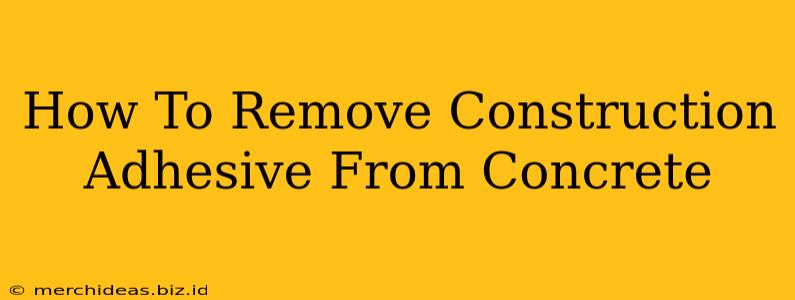Construction adhesive is incredibly strong, which is great for its intended purpose. But when you need to remove it from concrete, it can become a real headache. This comprehensive guide will walk you through the best methods for removing construction adhesive from concrete, no matter how stubborn it is. We'll cover everything from simple scraping to more aggressive chemical solutions, ensuring you get the job done efficiently and effectively.
Understanding the Adhesive
Before diving into removal methods, it's crucial to understand what you're dealing with. Construction adhesives come in various formulations, including polyurethane, epoxy, and silicone-based products. Each type reacts differently to cleaning agents and removal techniques. Identifying the specific type of adhesive will help you choose the most effective approach. Check the product label if possible, as this will often provide cleaning instructions.
Tools and Materials You'll Need
Having the right tools readily available will make the process significantly smoother and faster. You'll likely need some or all of the following:
- Scraping Tools: A putty knife (various sizes), a scraper with a razor-sharp edge, and a wire brush are your best friends for initial removal.
- Cleaning Agents: Depending on the adhesive type, you might need mineral spirits, acetone, denatured alcohol, or a commercial adhesive remover. Always test any cleaning agent on a small, inconspicuous area of the concrete first to ensure it doesn't damage the surface.
- Personal Protective Equipment (PPE): Safety glasses, gloves, and a respirator (especially when working with solvents) are essential to protect your health.
- Pressure Washer (Optional): A pressure washer can be extremely helpful for removing softened adhesive residue.
- Shop Towels or Rags: Plenty of clean rags are needed for wiping and cleaning.
Step-by-Step Removal Process
The removal process generally involves these steps:
1. Preparation is Key
Start by assessing the amount and type of adhesive. Is it a thin layer or a thick, stubborn mass? This will help determine the best approach. Wear your PPE before starting.
2. Initial Scraping
Use your putty knife or scraper to remove as much of the adhesive as possible. Work carefully to avoid damaging the concrete. A wire brush can help dislodge stubborn bits that refuse to scrape off.
3. Chemical Treatment (If Necessary)
If scraping alone isn't sufficient, apply the appropriate chemical solvent. Follow the manufacturer's instructions carefully. Always work in a well-ventilated area. Allow the solvent to dwell on the adhesive according to the instructions before attempting to remove it again.
4. Repeat Scraping and Cleaning
After the chemical treatment, repeat the scraping and cleaning process. You might need to apply the solvent multiple times, depending on the adhesive's tenacity.
5. Pressure Washing (Optional)
For softened adhesive residue, a pressure washer can quickly and effectively clean the concrete surface. Maintain a safe distance to avoid damaging the concrete.
6. Final Cleaning
Once the adhesive is removed, thoroughly clean the concrete with water and a stiff brush. Allow the area to dry completely.
Choosing the Right Cleaning Agent
The selection of the right cleaning agent hinges on the adhesive type:
- Polyurethane Adhesives: Often respond well to mineral spirits or a commercial adhesive remover.
- Epoxy Adhesives: Can be challenging to remove. Commercial epoxy removers are usually necessary.
- Silicone Adhesives: May require specific silicone removers.
Preventing Future Adhesive Problems
- Masking: Use painter's tape to protect surrounding areas when applying construction adhesive.
- Clean Application: Avoid excessive adhesive application.
- Proper Surface Prep: Ensure the concrete is clean and dry before applying the adhesive.
Removing construction adhesive from concrete can be a laborious process, but with the right tools, techniques, and safety precautions, you can achieve satisfactory results. Remember always to prioritize safety and carefully consider the type of adhesive you're dealing with to choose the most effective removal method.
